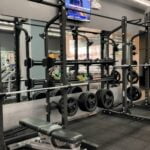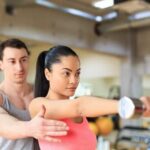Are you ready to hit the slopes this winter? Before you strap on your skis, it’s important to ensure that your body is prepared for the physical demands of skiing. In this article, we will explore a variety of exercises to get ski fit and help you maximize your performance on the snow.
Getting in shape for skiing goes beyond just being able to handle the physical exertion – it can also help prevent injuries and enhance your overall experience on the mountain. From cardiovascular exercises for endurance to strength training for skiing-specific muscles, we’ll cover all aspects of ski fitness to ensure you are fully prepared for the upcoming season.
Whether you’re a seasoned skier or a beginner, these exercises and fitness tips will help you build the strength, endurance, agility, and stability needed to conquer the slopes with confidence. We’ll also discuss injury prevention strategies, nutrition and hydration tips, as well as the importance of recovery and rest for optimal performance. So let’s get started on getting ski fit.
Preparing Your Body for the Ski Season
As the ski season approaches, it’s essential to start preparing your body for the physical demands of skiing. Engaging in specific exercises to get ski fit will help improve your cardiovascular endurance, strength, flexibility, balance, and overall stability on the slopes. By incorporating a well-rounded fitness regimen into your routine, you can reduce the risk of injury and enhance your performance during skiing.
To kickstart your ski fitness journey, consider integrating the following exercises into your workout plan:
- Cardiovascular Exercises: Incorporate activities such as cycling, running, or using the stair climber to build endurance and stamina.
- Strength Training: Focus on developing leg muscles with exercises like squats, lunges, and deadlifts to enhance power and control while skiing downhill.
- Flexibility and Balance Workouts: Practice yoga or incorporate stretching routines to improve flexibility in key areas such as hips, hamstrings, and ankles for better maneuverability on the snow.
In addition to these exercises, it’s crucial to include core workouts in your training regimen. A strong core is vital for maintaining stability and control while navigating twists and turns on the mountain. Engage in exercises like planks, Russian twists, and mountain climbers to strengthen your core muscles.
By incorporating a variety of exercises focused on cardiovascular endurance, strength training, flexibility and balance work, as well as core workouts into your fitness routine before hitting the slopes. You can significantly enhance your overall performance while reducing the risk of potential injuries during skiing.
Remember that proper nutrition and hydration play an important role in maximizing your ski fitness efforts. It’s important not only to fuel your body for optimal performance but also aid in muscle recovery after intense workouts.
Cardiovascular Exercises for Endurance
Cardiovascular fitness is an essential component of being ski fit. When hitting the slopes, skiers need to have enough endurance to be able to make it through a full day of skiing without feeling fatigued. Engaging in regular cardiovascular exercises can help improve lung capacity, strengthen the heart, and enhance overall endurance levels.
Types of Cardiovascular Exercises
There are several types of cardiovascular exercises that can help improve endurance for skiing. Activities such as running, cycling, swimming, and using the elliptical machine are all effective ways to elevate the heart rate and increase stamina. It’s important to engage in these activities at least three to four times a week for optimal results.
Interval Training
In addition to traditional cardiovascular exercises, interval training can be particularly beneficial for skiers. This type of workout involves alternating between periods of high-intensity activity and lower-intensity recovery periods. Not only does it simulate the fluctuating intensity levels experienced while skiing, but it also helps improve overall cardiovascular fitness and endurance.
Additional Considerations
It’s important to gradually increase the intensity and duration of cardiovascular workouts over time in order to continually challenge the body and gradually improve endurance levels. Additionally, incorporating activities that mimic the movements involved in skiing, such as uphill walking or hiking, can also be beneficial for enhancing overall ski fitness. By incorporating these specific exercises into your workout routine, you can significantly improve your endurance and maximize your enjoyment on the slopes.
Strength Training for Skiing
Strength training is an essential component of preparing your body for the ski season. By incorporating strength training exercises into your fitness routine, you can improve your muscle power and endurance, which are crucial for navigating the slopes with ease. Here are some effective strength training exercises to get ski fit:
- Squats: Squats are a fundamental exercise that targets the muscles used during skiing, such as the quadriceps, hamstrings, and glutes. Perform squats with proper form and gradually increase the weight as you build strength.
- Lunges: Lunges help strengthen the muscles in your legs and increase stability, which is important for maintaining control while skiing. Add variations such as walking lunges or reverse lunges to target different muscle groups.
- Deadlifts: Deadlifts work the muscles in your lower back, hamstrings, and glutes, which are essential for maintaining good posture and stability while skiing. Focus on maintaining proper form to avoid injury.
In addition to these primary strength training exercises, it is also beneficial to incorporate upper body workouts to improve overall body strength. This can include exercises such as push-ups, pull-ups, and dumbbell rows to enhance your ability to maneuver through various skiing terrains.
By including these strength training exercises in your workout regimen, you can build the muscle strength and endurance needed for a successful ski season. As with any new exercise routine, it’s important to consult with a professional trainer or fitness expert to ensure that you are performing these exercises correctly and safely.
Flexibility and Balance Exercises for Skiing
Flexibility and balance are crucial components of ski fitness. Without these, skiers are more prone to injury and may not be able to maneuver the slopes as effectively. Incorporating specific exercises to improve flexibility and balance can greatly enhance a skier’s performance.
Yoga for Flexibility
Yoga is an excellent way to increase overall flexibility, which is important for reducing the risk of muscle strains and tears while skiing. Poses such as downward dog, pigeon pose, and seated forward bend target the muscles used during skiing, such as the hamstrings, quadriceps, and calves. Additionally, yoga helps improve balance through various standing poses like tree pose and warrior III.
Bosu Ball Workouts for Balance
The Bosu ball is an effective tool for balancing exercises that mimic the unstable surface of snow. Skiers can perform exercises such as single-leg squats, lunges, and heel raises on the Bosu ball to strengthen stabilizing muscles in their legs and core. This type of training can significantly improve a skier’s ability to maintain control while navigating uneven terrain on the slopes.
Dynamic Stretching for Skiing
Dynamic stretching involves controlled movements that gradually increase a skier’s range of motion and help prepare the body for physical activity. Leg swings, arm circles, and torso twists are examples of dynamic stretching exercises that can be incorporated into a pre-ski warm-up routine.
These movements encourage blood flow to the muscles while promoting balance and coordination – all essential elements for successful skiing. Incorporating these flexibility and balance exercises into a comprehensive ski fitness regimen will ensure that skiers are adequately prepared for the demands of the sport.
Core Workouts for Stability and Control on the Slopes
When it comes to skiing, having a strong and stable core is essential for maintaining control on the slopes. Your core muscles, including your abdominals, obliques, and lower back muscles, play a crucial role in maintaining proper posture and balance while skiing. Engaging in specific core workouts can help improve your stability, minimize the risk of injury, and enhance your overall skiing performance.
One effective exercise to strengthen your core for skiing is the plank. By holding a plank position for 30 seconds to a minute, you can engage your abdominal muscles, lower back, and shoulders. This helps build endurance and stability in your core, which is vital for navigating varied terrain while skiing. Additionally, incorporating exercises like Russian twists, bicycle crunches, and leg raises into your workout routine can further target and strengthen the muscles needed for stability on the slopes.
Incorporating these core workouts into your fitness regimen can greatly benefit your skiing experience. Not only will you be able to maintain better control over your movements while skiing, but you’ll also reduce the risk of experiencing fatigue or strain in your core muscles during extended periods on the slopes. By prioritizing core strength through targeted exercises, you can enhance your overall skiing performance and enjoy a more enjoyable and satisfying experience on the mountain.
Plyometric Exercises to Improve Power and Agility
Plyometric exercises are a key component of any ski fitness routine, as they focus on explosive movements that can significantly improve an individual’s power and agility on the slopes. These exercises involve rapid stretching and contracting of muscles, which ultimately leads to improved muscle strength, coordination, and overall athletic performance. When it comes to skiing, having strong and agile muscles is essential for navigating the terrain and maintaining control at high speeds.
One effective plyometric exercise for skiers is box jumps. This exercise involves jumping onto a raised platform or box from a standing position, then stepping back down and repeating the process. Box jumps help develop lower body strength, power, and explosiveness, all of which are crucial for quick turns and sudden changes in direction while skiing.
Another beneficial plyometric exercise for ski fitness is lateral jumps. This exercise requires jumping laterally from side to side over an object or line, focusing on quick and explosive movements to build overall agility and coordination. Lateral jumps mimic the side-to-side movements often encountered while skiing, making them particularly useful for improving dynamic balance and control.
In addition to box jumps and lateral jumps, skiers can also incorporate exercises such as depth jumps, bounding, and squat jumps into their plyometric training routine. It’s important to note that proper form and technique are essential when performing plyometric exercises to avoid injury.
Therefore, it’s recommended to start with lower-intensity variations of these exercises and gradually increase intensity as strength and proficiency improve. Incorporating plyometric exercises into a comprehensive ski fitness program can significantly enhance a skier’s power, agility, and overall performance on the slopes.
Injury Prevention Exercises for Skiing
Participating in winter sports like skiing can be exhilarating, but it also comes with the risk of injury. To minimize these risks, it’s essential to incorporate injury prevention exercises into your ski fitness routine. Strengthening key muscle groups and improving overall flexibility can help protect your body from common skiing injuries.
One crucial area to focus on is the lower body, especially the quadriceps, hamstrings, and calves. These muscles play a significant role in absorbing impact and providing stability while skiing. Exercises such as squats, lunges, calf raises, and leg curls can help strengthen these muscle groups and reduce the risk of strains or tears while on the slopes.
In addition to lower body strength, it’s important to work on core stability and balance to prevent falls and minimize the impact of any tumbles. Incorporating exercises like planks, Russian twists, and stability ball workouts can help improve core strength and balance, making it easier to maintain control while skiing downhill.
By incorporating a well-rounded set of injury prevention exercises into your ski fitness routine, you can enjoy the slopes with confidence while minimizing the risk of common skiing-related injuries.
| Exercise | Description |
|---|---|
| Squats | A compound exercise that strengthens the quadriceps, hamstrings, and glutes. |
| Planks | An isometric core exercise that helps improve abdominal strength and stability. |
| Calf Raises | An exercise targeting the calves for improved lower leg strength. |
Nutrition and Hydration Tips for Ski Fitness
Proper nutrition and hydration are essential components of ski fitness. In order to have the energy and stamina required for a day on the slopes, skiers must fuel their bodies with the right nutrients and stay well-hydrated. A balanced diet that includes carbohydrates, protein, healthy fats, vitamins, and minerals is crucial for maintaining energy levels and supporting muscle recovery after intense physical activity.
Carbohydrates are especially important for providing the necessary fuel for skiing. Complex carbohydrates like whole grains, fruits, and vegetables can help sustain energy levels throughout the day. Additionally, protein is essential for muscle repair and growth, so incorporating lean sources of protein such as chicken, fish, beans, and legumes is beneficial for ski fitness. It’s also important to stay hydrated by drinking plenty of water before hitting the slopes and continue to hydrate throughout the day.
In terms of timing, skiers should aim to eat a well-balanced meal a couple of hours before hitting the slopes. This meal should include complex carbohydrates, lean protein, and healthy fats to provide sustained energy. Snacks like nuts, dried fruits, or energy bars can also help maintain energy levels during breaks from skiing.
| Nutrition Tips | Hydration Tips |
|---|---|
| Include complex carbohydrates in meals | Drink plenty of water before skiing |
| Incorporate lean protein sources | Continue to hydrate throughout the day |
| Eat balanced meals a few hours before skiing | Choose snacks that help maintain energy levels |
Recovery and Rest for Optimal Performance
In conclusion, getting ski fit requires a comprehensive approach that encompasses cardiovascular endurance, strength training, flexibility and balance exercises, core workouts, plyometric exercises, injury prevention techniques, and proper nutrition and hydration. However, equally important is the aspect of recovery and rest for optimal performance on the slopes.
After engaging in intense physical activities such as skiing-specific workouts and training routines, it is crucial to allow the body to recover and rest. This helps in preventing overuse injuries and exhaustion while also allowing the muscles to repair and rebuild. Adequate recovery time can also improve overall performance on the slopes as well as reduce the risk of fatigue-related accidents or mistakes.
Skiing places significant demands on the body, with its combination of endurance, strength, stability, and agility requirements. Therefore, properly managing recovery through good sleep habits, relaxation techniques, and incorporating rest days into your routine is essential for both your physical well-being and skiing performance.
In addition to this, self-care practices like massage therapy or foam rolling can contribute to faster recovery after intense ski fitness sessions. Ultimately balancing a challenging workout regimen with sufficient recovery time will allow skiers to achieve peak physical fitness levels for an enjoyable and safe skiing experience.
Frequently Asked Questions
What Is the Fastest Way to Get in Shape for Skiing?
The fastest way to get in shape for skiing is to focus on exercises that build strength, endurance, and flexibility. This can include activities like squats, lunges, leg presses, core work, and cardio training to improve overall fitness.
How to Get Ski Fit in 3 Weeks?
Getting ski fit in 3 weeks involves a combination of targeted workouts focused on building leg strength, improving balance and stability, and increasing cardiovascular endurance. It’s important to incorporate both strength training and aerobic exercises into your routine.
What Are the Best Exercises to Prepare for Skiing?
The best exercises to prepare for skiing are those that target the muscles used most during skiing. This includes exercises like squats, lunges, leg presses, calf raises, core workouts, and agility drills. Additionally, activities like cycling and running can help improve cardiovascular fitness for better endurance on the slopes.

Passionate about providing useful information to anyone with an interest in the field of Personal Training, I strive to pass on to our readers quality information and to answer any questions about Personal Trainers, the work they do and how to become one.





